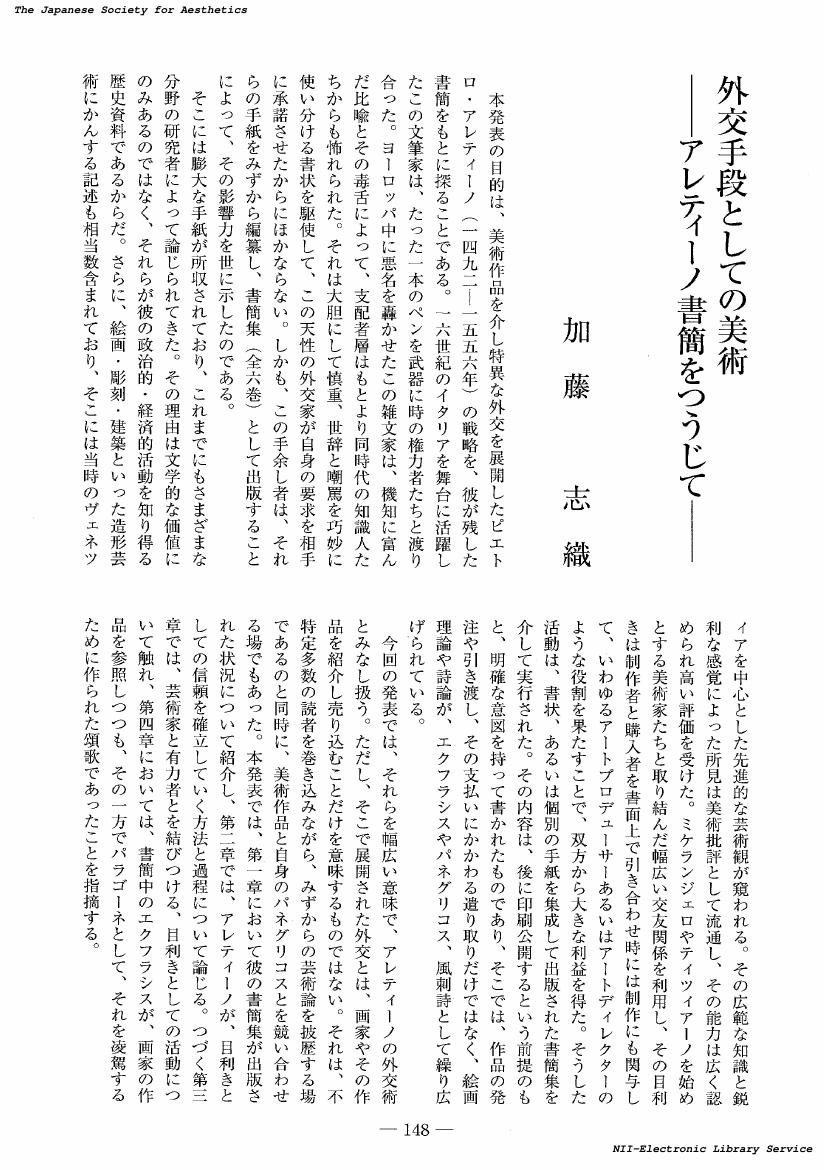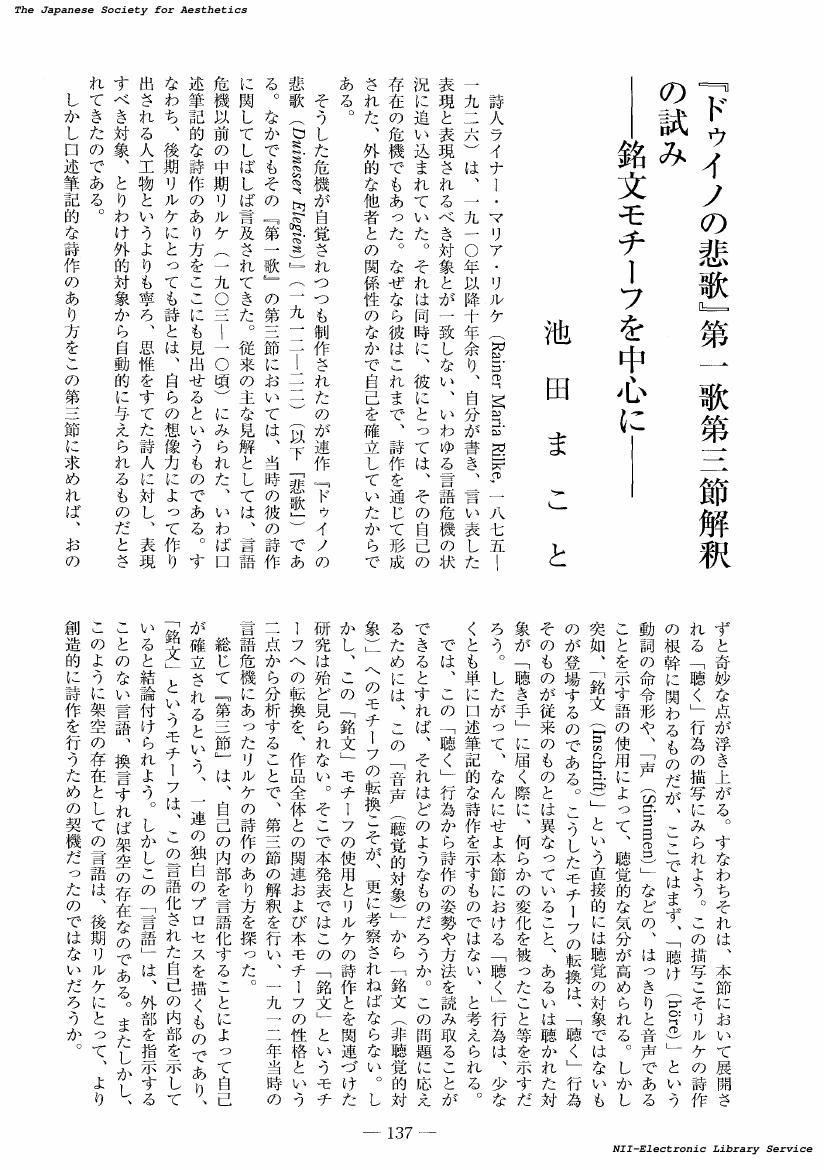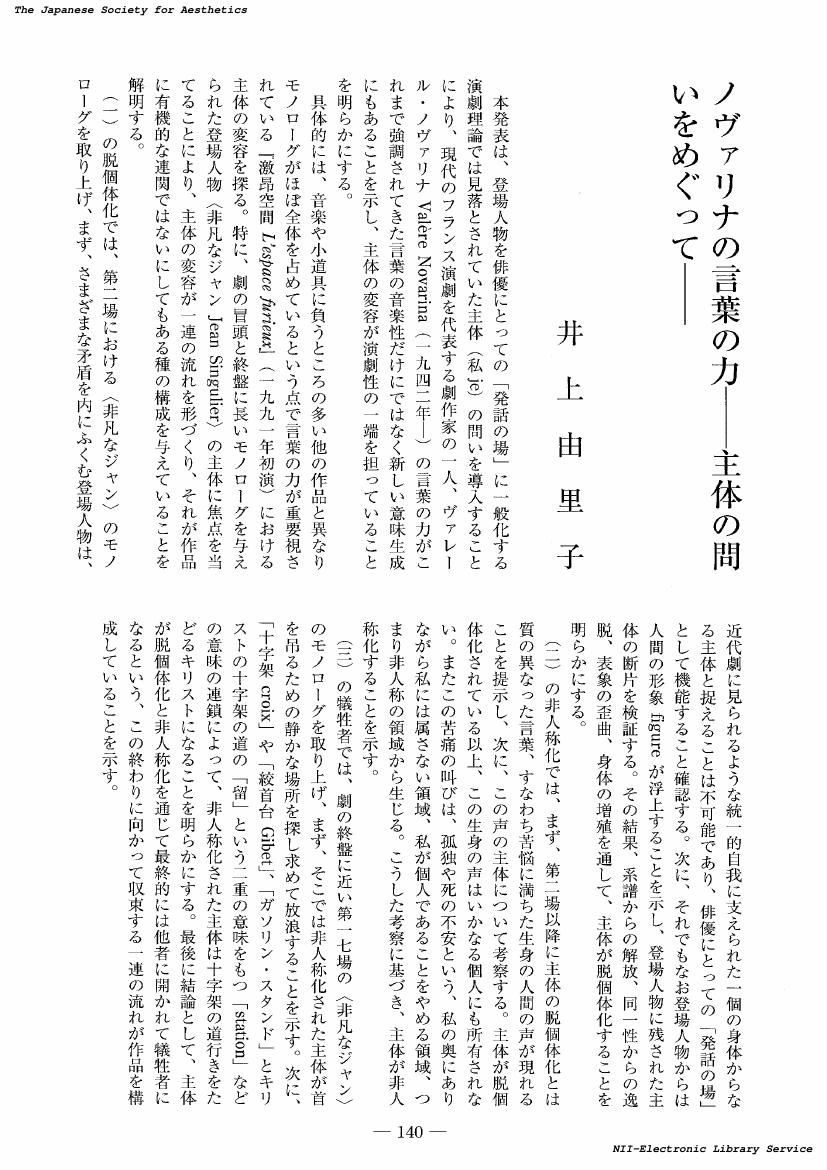- 著者
- 大愛 崇晴
- 出版者
- 美学会
- 雑誌
- 美学 (ISSN:05200962)
- 巻号頁・発行日
- vol.59, no.2, pp.142, 2008-12-31 (Released:2017-05-22)
1 0 0 0 OA 場所的想像力 : 形象性を包越した関係性の表象(第五十九回美学会全国大会発表要旨)
- 著者
- 大石 昌史
- 出版者
- 美学会
- 雑誌
- 美学 (ISSN:05200962)
- 巻号頁・発行日
- vol.59, no.2, pp.143, 2008-12-31 (Released:2017-05-22)
1 0 0 0 OA エミール・ノルデの様式決定に関する一考察(第五十九回美学会全国大会発表要旨)
- 著者
- 大浦 周
- 出版者
- 美学会
- 雑誌
- 美学 (ISSN:05200962)
- 巻号頁・発行日
- vol.59, no.2, pp.144, 2008-12-31 (Released:2017-05-22)
1 0 0 0 OA 幻燈旅行講演にみる旅行イメージの変容(第五十九回美学会全国大会発表要旨)
- 著者
- 大畑 光範
- 出版者
- 美学会
- 雑誌
- 美学 (ISSN:05200962)
- 巻号頁・発行日
- vol.59, no.2, pp.145, 2008-12-31 (Released:2017-05-22)
- 著者
- 小河原 あや
- 出版者
- 美学会
- 雑誌
- 美学 (ISSN:05200962)
- 巻号頁・発行日
- vol.59, no.2, pp.146, 2008-12-31 (Released:2017-05-22)
- 著者
- 尾鼻 崇
- 出版者
- 美学会
- 雑誌
- 美学 (ISSN:05200962)
- 巻号頁・発行日
- vol.59, no.2, pp.147, 2008-12-31 (Released:2017-05-22)
1 0 0 0 OA 外交手段としての美術 : アレティーノ書簡をつうじて(第五十九回美学会全国大会発表要旨)
- 著者
- 加藤 志織
- 出版者
- 美学会
- 雑誌
- 美学 (ISSN:05200962)
- 巻号頁・発行日
- vol.59, no.2, pp.148, 2008-12-31 (Released:2017-05-22)
1 0 0 0 OA ベルクソン感性論と現代聴覚性(第五十九回美学会全国大会発表要旨)
- 著者
- 金子 智太郎
- 出版者
- 美学会
- 雑誌
- 美学 (ISSN:05200962)
- 巻号頁・発行日
- vol.59, no.2, pp.149, 2008-12-31 (Released:2017-05-22)
1 0 0 0 OA パウル・クレーの<天使>について : <都市画>との関連から
- 著者
- 松友 知香子
- 出版者
- 美学会
- 雑誌
- 美学 (ISSN:05200962)
- 巻号頁・発行日
- vol.59, no.2, pp.86-99, 2008-12-31 (Released:2017-05-22)
Der Engel, den P. Klee (1879-1940) in seinen letzten Lebensjahren dargestellt hat, bedarf einer Untersuchung, die nicht nur auf seine individuelle Lebensgeschichte und seine psychologische Probleme, sondern auch auf die geistesgeschichtliche Situation seiner Zeit bezogen wird. In diesem Zusammenhang ist darauf zu achten, dass seine Engel-Bilder in einem engen Zusammenhang mit seinen Stadt-Bildern zu stehen scheinen. Zeitlich treten die erstere am meisten gegen Ende der dreissiger Jahren auf, wahrend die letzteren meistens in zwanziger Jahren hergestellt wurden. Inhaltlich betrachtet, kann die oft in den Stadt-Bildern dargestellte "Scheibe" so angesehen werden, dass sie in ihrer symbolischen Bedeutung spater mit der Gestalt des Engels ersetzt wird. Die beiden drucken dieselbe Atmosphare aus: die Hoffnung auf das bessere und die Angst um das miserable Leben, die Sehnsucht nach der verlorenen Natur, die Furcht vor dem heranschleichenden Schicksal der Katastrophe usw.. Der Ubergang von der Stadt-Bilder zur Engel-Bilder ist im Hinblick auf die bildnerischen Charaktere zu verfolgen. Der Grund fur den Wechsel der zwei Motive soll aber auch, wie oben gesagt, in vielschichtigen Perspektiven erklart werden. Der Engel stellt direkter und konkreter aus, was die "Scheibe" in den Stadt-Bildern symbolisch darstellt. Weiterhin: Klee's Engel ist geistesgeschichtlich im Hinblick auf den historischen Wandel der Auffassung des Engels der Neuzeit in Betracht zu ziehen.
1 0 0 0 OA 土田麥僊「平牀」と「妓生の家」について : 近代日本美術における朝鮮の美をめぐって
- 著者
- 上田 文
- 出版者
- 美学会
- 雑誌
- 美学 (ISSN:05200962)
- 巻号頁・発行日
- vol.59, no.2, pp.100-113, 2008-12-31 (Released:2017-05-22)
TSUCHIDA Bakusen (土田麥僊 1887-1936) was a modern Japanese painter in Kyoto. The purpose of this thesis is to consider his two works in his later years, Flat Bed (「平牀」) and House of Courtesan (「妓生の家」). Flat Bed is recently discussed in colonial studies and gender theories. Bakusen is an artist who treats the model as an object and therefore the kisaeng in his works is not treated as sexual object. The kisaeng's white folk dress line suggests "relief' in this work, which expresses the painter's artistic sense. House of Courtesan was sketched during his second visit to Korea and he could not finish this work because of his death. Here he depicted an old man, an old woman and a kisaeng; the theme differed from his former works. Therefore, I think this change was due to his visits to Korea where he was influenced by Portrait of Li Qixian, a famous scholar in Koryo Dynasty, and Portrait of Gonso Sojo, a Japanese religious picture. In his new portrait painting he tries to unite a portrait and a religious picture. By comparing his two works in this thesis, it can be stated that Bakusen is a modern Japanese painter who developed a new style of arts from the inspiration of Korean works.
- 著者
- 河合 大介
- 出版者
- 美学会
- 雑誌
- 美学 (ISSN:05200962)
- 巻号頁・発行日
- vol.59, no.2, pp.128-130, 2008-12-31 (Released:2017-05-22)
- 著者
- 池田 まこと
- 出版者
- 美学会
- 雑誌
- 美学 (ISSN:05200962)
- 巻号頁・発行日
- vol.59, no.2, pp.137, 2008-12-31 (Released:2017-05-22)
- 著者
- 石谷 治寛
- 出版者
- 美学会
- 雑誌
- 美学 (ISSN:05200962)
- 巻号頁・発行日
- vol.59, no.2, pp.138, 2008-12-31 (Released:2017-05-22)
1 0 0 0 OA B・ゴート:「芸術クラスター説」の検討と応用(第五十九回美学会全国大会発表要旨)
- 著者
- 伊藤 佐紀
- 出版者
- 美学会
- 雑誌
- 美学 (ISSN:05200962)
- 巻号頁・発行日
- vol.59, no.2, pp.139, 2008-12-31 (Released:2017-05-22)
1 0 0 0 OA ノヴァリナの言葉の力 : 主体の問いをめぐって(第五十九回美学会全国大会発表要旨)
- 著者
- 井上 由里子
- 出版者
- 美学会
- 雑誌
- 美学 (ISSN:05200962)
- 巻号頁・発行日
- vol.59, no.2, pp.140, 2008-12-31 (Released:2017-05-22)
- 著者
- 平山 敬二
- 出版者
- 美学会
- 雑誌
- 美学 (ISSN:05200962)
- 巻号頁・発行日
- vol.59, no.1, pp.196-197, 2008-06-30 (Released:2017-05-22)
1 0 0 0 OA T・E・ヒュームの芸術論と原(プロト)ファシズム・イデオロギー
- 著者
- 石田 圭子
- 出版者
- 美学会
- 雑誌
- 美学 (ISSN:05200962)
- 巻号頁・発行日
- vol.59, no.2, pp.2-15, 2008-12-31 (Released:2017-05-22)
T. E. Hulme, an aesthetician and a critic, is famous for his contribution to Imagism, one of the most important movements of Anglo-American Modernism. This leading figure of Modernism is also notorious as a sympathizer of protofascism who celebrates Charles Maurras and Georges Sorel. In this paper, I try to analyze the relation between Hulme's aesthetics and the ideology of protofascism. In his essays, rejecting the sensibility of Romanticism, Hulme insists on the superiority of Classicism, which is, actually, deeply affected by the political and literary view of Maurras who regards Classicism as 'anti' to liberalism and democracy. Moreover his keen interest in geometric-abstract art reflects his worldview - reactionary modernism whose core is 'the religious attitude'. In this view, he supports Sorel's political theory in which he finds Classicism and the religious attitude. Finally I point out the homogeneity between Hulme's idea and protofascistic Weltanschauung by taking an overview on the rise of irrationalism and the vulgarized Lebensphilosophie. This close relationship between aesthetics and protofascism in Hulme's thought suggests that Modernism and fascism, the two concepts that are widely assumed to be antithetical, might partly have an profound kinship.
1 0 0 0 OA フーコーにおける「感性論」の可能性 : 「外」との関わりから
- 著者
- 武田 宙也
- 出版者
- 美学会
- 雑誌
- 美学 (ISSN:05200962)
- 巻号頁・発行日
- vol.59, no.2, pp.30-43, 2008-12-31 (Released:2017-05-22)
Cet article se propose d'expliciter le rapport de Michel Foucault a l'esthetique a partir d'un concept du dehors. Qu'est-ce que Foucault entend exactement par <<dehors>>? En reconstituant le jeu que joue ce concept ou en suivant les variations de ce <<dehors>> dans la pensee de ce philosophe, je voudrais formuler une hypothese: que ce concept, qu'il arrache aux textes de Maurice Blanchot dans La pensee du dehors se situe au centre de l'esthetique de Foucault. Une de ces variations, c'est <<l'enonce>> qu'il a propose dans L'archeologie du savoir. C'est une unite dans le discours a laquelle il a donne une certaine qualite de<<materialite incorporelle>>, qui est derivee du stoisisme ou la subjectivite est structuree selon un mode different de celui de la conscience. On peut entendre ici la resonance de <<l'autre dans le Meme>>, ce que Emmanuel Levinas a evoque dans son oeuvre. On voit egalement le dernier theme que Foucault s'est efforce a rechercher: la vie comme oeuvre d'art. Il a pense qu'il y a un moment d'une prise de relations avec l'exteriorite dans l'interiorite. Cette recherche conduit finalement a un chiasme de l'esthetique et de l'ethique. Il me semble que son attention sur l'ethique indique l'indifferenciation originaire des deux, que l'esthetique moderne a elimine.
1 0 0 0 OA 融解する表面 : ヘレニズム以前のギリシアにおけるプロソポンの考察
- 著者
- 佐藤 真理恵
- 出版者
- 美学会
- 雑誌
- 美学 (ISSN:05200962)
- 巻号頁・発行日
- vol.59, no.2, pp.44-57, 2008-12-31 (Released:2017-05-22)
A classical Greek noun, prosopon originally means both face and mask. This paper takes advantage of the reason why this term connotes both of them, which seem directly-opposed ideas by our means. Prosopon is consisted of prefix pros and noun ops, and signifies the thing towards etes literally. It is, to sum up, appearance as surface-front, and dislocates structure of binomial confrontation between face and mask. Nevertheless, it is also impossible to disregard the rest of prosopon which is beyond description in just an aspect above-mentioned of it. Because, prosopon which need the others and is given by the exterior, is fated to be read by someone confront, for indeed its character it is open for and exists in the exterior. And, from a point of view of the watching it, these surface prosopon is a field presence and absence crossing. However, in the other side, in the ancient Greek texts, the action that restores its primary mean as appearance has applied to a moment for conquer a fear of death. Anyway, different from a modern concept, prosopon in the ancient Greek is heteronomous, the face that could not but start from the character of surface-front.
- 著者
- 佐々木 千佳
- 出版者
- 美学会
- 雑誌
- 美学 (ISSN:05200962)
- 巻号頁・発行日
- vol.59, no.2, pp.58-71, 2008-12-31 (Released:2017-05-22)
Un noto ritratto virile, oggi conservato alla Biblioteca Trivulziana di Milano su un foglio miniato, ci presenta un' immagine molto originate e simbolica. L'attenzione degli studiosi e stata lungamente ed esclusivamente attratta da problemi stilistici e di attribuzione, nonche dalla questione dell'identita del soggetto rappresentato, ma senza una adeguata considerazione della funzione dell'opera come ritratto dell'autore del testo della pergamena a cui l'immagine e ancorata come un dono. La Fletcher (1991) ha riconosciuto nel ritratto un'opera di Giovanni Bellini, finora ritenuta perduta, appartenente in origine al manoscritto del Istrias di Raffaele Zovenzoni. Sulla base di questa ipotesi da noi condivisa, ci sembra opportuno collocare l'opera sullo sfondo di una specifica e importantissima attivita tecnico-artigianale dell'epoca, quella della produzione e decorazione libraria. Si puo riconoscere nel ritratto l'effigie dell' autore del testo delle odi dell' Istrias, a cui si accompagna in un rapporto intertestuale di simbolicita-individualita determinato dalla finalita della sua destinazione. Il pittore idealizza l'immagine del poeta usando motivi architettonici e attributi tipici della tradizione della decorazione libraria, evocando una presence reelle dello sguardo dell'autore delle odi direttamente rivolto al dedicatario come un sostituto reale del donatore. Proprio questa, a nostro avviso, e la funzione originaria e it significato dell'immagine nel contesto funzionale e nella sua posizione cronologica nella seconda meta del Quattrocento.













